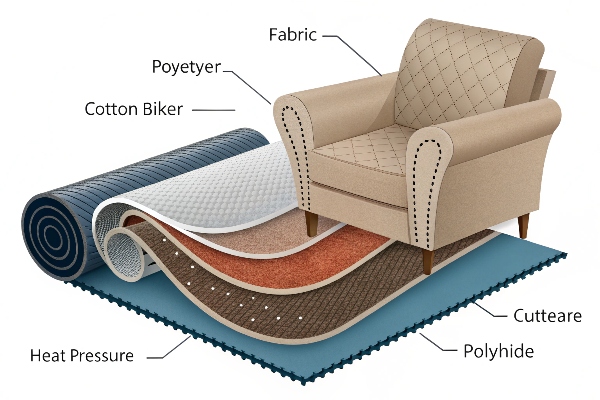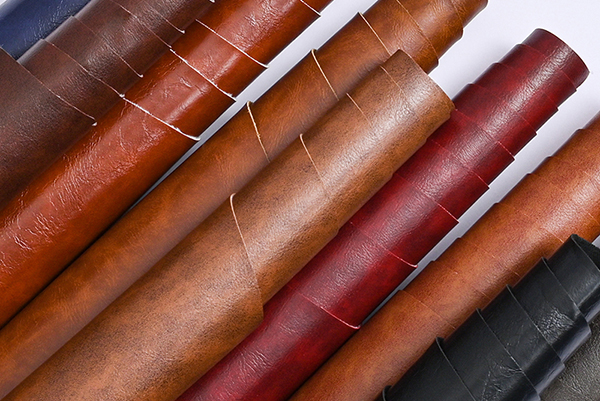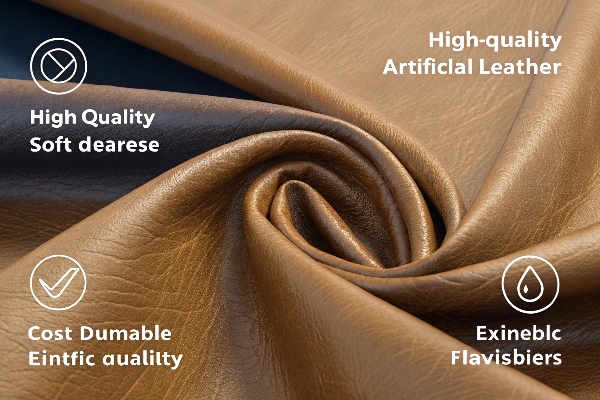I see buyers struggle with price and planet, then freeze. They fear the wrong choice will cost money and reputation, yet the clock ticks.
Artificial leather is a man-made material that mimics real hide by layering plastic resins—mostly PU or PVC—onto a fabric base, giving a leather-like look without animal skin.

You want to know if fake leather is smart or risky. I will break down the facts, share what I learned in ten years of trade, and show when it outperforms and when it fails. Stay with me.
What is artificial leather made of?
Shoppers often picture mystery chemicals and hidden hazards. The uncertainty stalls every project.
Artificial leather blends a textile backer—usually polyester, cotton, or microfiber—with a surface layer of polyurethane (PU) or polyvinyl chloride (PVC). Heat and pressure bond them, then embossing adds grain.

Core Layers in Simple Terms
| Layer | Common Material | Key Role | What I Watch |
|---|---|---|---|
| Base fabric | Polyester, cotton, or recycled PET | Gives strength and shape | Tear strength, yarn density |
| Foam coat | PU or PVC foam | Adds softness and bulk | Cell size, odor |
| Skin coat | High-solid PU or PVC | Provides grain and color | Scratch test, color fastness |
| Top finish | Water-based PU, acrylic, or silicone | Boosts stain and UV resistance | VOC level, feel |
I walk factory floors weekly. PU lines run at lower temps and create fewer fumes, so workers breathe easier. PVC lines need higher heat and stabilizers with more additives. Recycled PET backers now replace virgin yarn in many mills.

When a U.K. furniture maker asked for 60,000 meters last spring, I leaned on a mill that uses 45% recycled content. This swap trimmed carbon by 12% and passed their audit.
Is artificial leather good?
Clients see shiny samples, yet doubt the real-world payoff. They fear cracking seats and angry reviews.
Good artificial leather balances cost, durability, and ethics. Quality PU grades stay supple, resist stains, and meet REACH and OEKO-TEX® rules, while saving 25-40% versus top-grain hide.

How I Judge “Good” in Four Steps
| Test | Method I Use | Pass Mark | Why It Matters |
|---|---|---|---|
| Martindale abrasion | 40k cycles with 12kPa | ≥30k cycles | Prevents early wear on sofas |
| Hydrolysis | 70°C, 95% RH, 7 days | No sticky surface | Predicts long-term peel |
| Flex at ‑20°C | 50k bends | No cracks | Needed for cold trucks |
| VOC check | GC-MS scan | <0.5 mg/m³ | Meets car makers’ limits |
Last year a Middle East bus maker ran my PU through these four checks. The seats stayed intact on a 55°C route, and they cut refurb costs by one-third. That win convinced them to switch their full fleet.
How long does artificial leather last?
Buyers hear numbers from six months to ten years. The spread scares them.
High-grade PU upholstery lasts five to eight years indoors and three to five years in cars under the sun, when cleaned and conditioned as the maker advises.

Lifespan Factors You Can Control
| Factor | Impact | Simple Fix |
|---|---|---|
| Resin type | PU > PVC for hydrolysis | Pick PU for humid zones |
| Thickness | 0.9 mm lasts longer than 0.6 mm | Ask for spec sheet |
| UV topcoat | Adds 1-2 years in cars | Request UV-400 finish |
| Cleaning method | Harsh solvents cut life by half | Use pH-neutral soap |
I still sit on a sample chair I upholstered in 2017 with 1.1 mm PU. It faced daily use in my office and looks fresh after light microfiber cloth wipes each Friday. That real seat beats every brochure claim I read.
What is the disadvantage of artificial leather?
The bright price and vegan tag hide flaws. I see many learn this late.
Artificial leather can trap heat, lacks the natural patina of hide, and lower-end PVC grades release more VOCs and crack sooner, leading to waste and extra cost.

Downsides and When They Matter
| Drawback | When It Hurts | My Work-around |
|---|---|---|
| Breathability | Luxury car seats, summer climate | Use microfiber backer, perforate |
| Aging look | High-end fashion bags | Offer waxy PU or hybrid with bio oil |
| Environmental load | Cheap PVC flooring | Switch to bio-based PU, recycled PET mesh |
| Repair limits | Boutique sofas needing re-dye | Sell spare yardage for panel swap |
A U.S. boutique couch brand once insisted on cheap PVC to cut launch costs. In year two, 18% of returns cited peeling. Warranty eats profits. They came back, we upgraded to a breathable PU and returns fell below 2%. Lesson: saving pennies upfront risks dollars later.
Conclusion
Artificial leather is a tool. Pick the right resin, base, and finish, and it serves for years; pick wrong, and it cracks fast. Choose informed, and win both cost and conscience.
